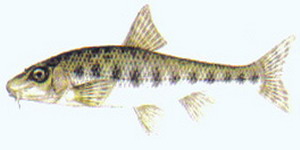

|

00 lbs |
05 oz |
00 drams |
00 kilos |
141 grams |
Year 1990 |
Distribution: A common little fish in Europe, where it can be found from the Pyrenees right through to Scandinavia. Like so many river fish, gudgeon are only naturally found in the South of England, but have been introduced to Wales, Scotland and Ireland. Now common throughout the British Isles in rivers and canals. Less common in lakes, owing to a lack of spawning habitat.
Features: A small fish, but with beautiful purple flashes on the flanks. Like its much larger cousin the barbel, this is a powerful fish that can often be found in fast flowing water. The underslung mouth and two barbules (barbel have four) are designed for feeding upon the river bed. Several sub-species exist in continental Europe, but have not been introduced to the British Isles.
Diet: Gudgeon are often found on clean gravel and sand beds, particularly where there are large amounts of submerged plants. Gudgeon love feeding upon copepods, tiny shelled invertebrates that form swarms just above the river bed. Tiny caddis larvae and small aquatic worms are also taken when available.
Spawning: When I used to work on the River Great Ouse we would use the gudgeon as a marker for the spawning of other species. Gudgeon spawn at the same time as roach and about 2-3 weeks before bream, bleak and chub. Because gudgeon spawn in shallow water their eggs are very easy to collect and so it was possible for us to check every day for spawning. Most books say that gudgeon spawn on clean gravel, but I have also found them spawning on fontinalis - the moss found stuck to stones on weir sills.
Growth: Like most small river fish, gudgeon do not live very long. In cool water they can live for six years, but in more productive fisheries three years is a good age. They reach sexual maturity at two years of age, allowing them to spawn twice before dying.
©Norfolk Fishing Network 2004 - 2025®All Rights Reserved.